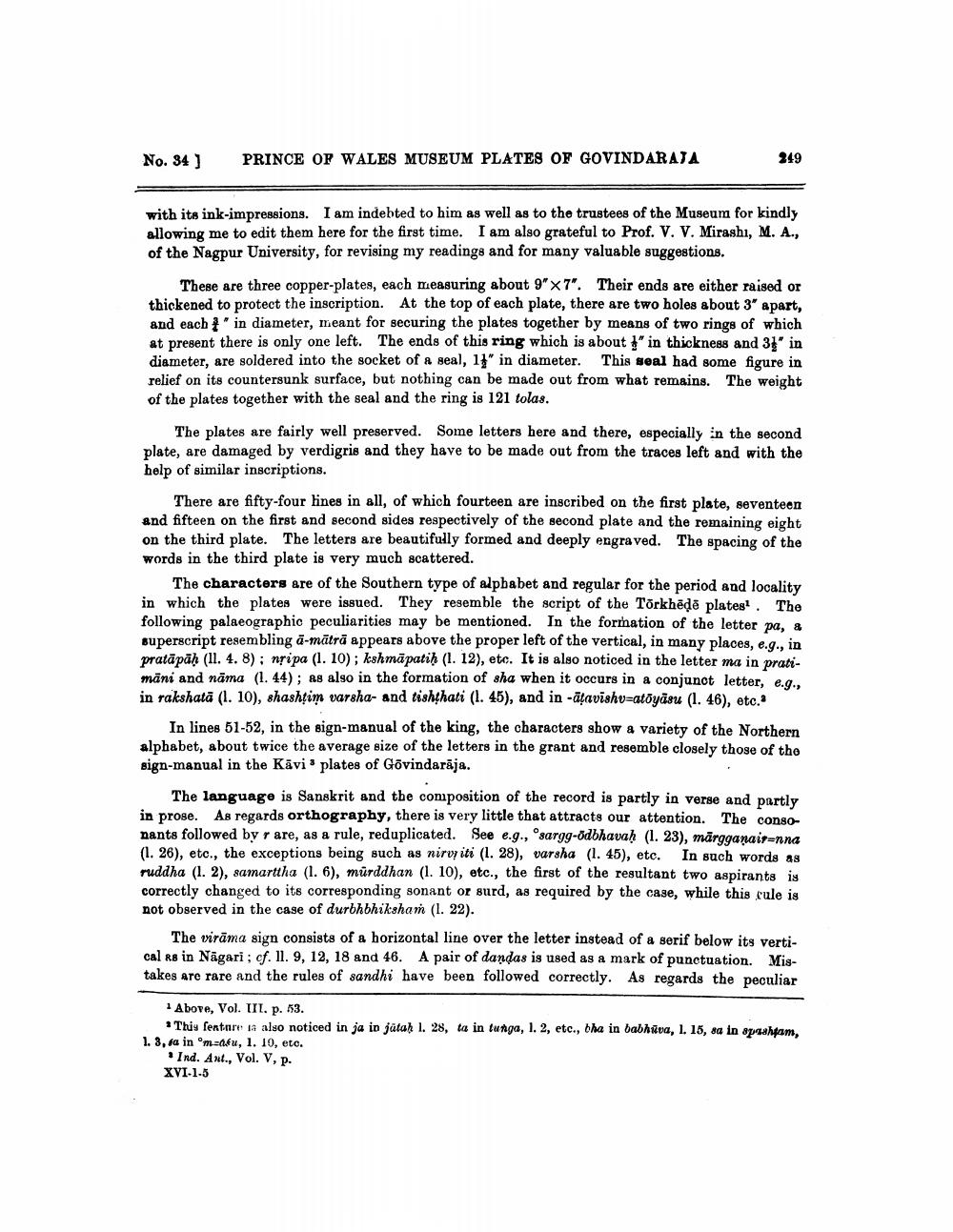________________
No. 34 )
PRINCE OF WALES MUSEUM PLATES OF GOVINDARAJA
249
with its ink-impressions. I am indebted to him as well as to the trustees of the Museum for kindly allowing me to edit them here for the first time. I am also grateful to Prof. V. V. Mirashi, M. A., of the Nagpur University, for revising my readings and for many valuable suggestions.
These are three copper-plates, each measuring about 9' X 7". Their ends are either raised or thickened to protect the inscription. At the top of each plate, there are two holes about 3' apart, and each t' in diameter, meant for securing the plates together by means of two rings of which at present there is only one left. The ends of this ring which is about }" in thickness and 31' in diameter, are soldered into the socket of a seal, 13" in diameter. This seal had some figure in relief on its countersunk surface, but nothing can be made out from what remains. The weight of the plates together with the seal and the ring is 121 tolas.
The plates are fairly well preserved. Some letters here and there, especially in the second plate, are damaged by verdigris and they have to be made out from the traces left and with the help of similar inscriptions.
There are fifty-four lines in all, of which fourteen are inscribed on the first plate, seventeen and fifteen on the first and second sides respectively of the second plate and the remaining eight on the third plate. The letters are beautifully formed and deeply engraved. The spacing of the words in the third plate is very much scattered.
The characters are of the Southern type of alphabet and regular for the period and locality in which the plates were issued. They resemble the script of the Torkhēdē plates. The following palaeographic peculiarities may be mentioned. In the formation of the letter pa, a superscript resembling ā-mātrā appears above the proper left of the vertical, in many places, e.g., in pratāpāh (1l. 4. 8); nripa (1. 10); kshmāpatih (1. 12), etc. It is also noticed in the letter ma in pratimäni and nāma (1. 44); As also in the formation of sha when it occurs in a conjunct letter, e.g., in rakshatā (1. 10), shashtim varsha- and tishthati (1. 45), and in -āšavishv=atoyāsu (1. 46), etc.
In lines 51-52, in the sign-manual of the king, the characters show a variety of the Northern alphabet, about twice the average size of the letters in the grant and resemble closely those of the sign-manual in the Kāvi plates of Govindarāja.
The language is Sanskrit and the composition of the record is partly in verse and partly in prose. As regards orthography, there is very little that attracts our attention. The congonants followed by r are, as a rule, reduplicated. See e.g., sargg-odbhavah (1. 23), mārgganair=nna (1. 26), etc., the exceptions being such as niruriti (1. 28), varsha (1. 45), etc. In such words as ruddha (1.2), samarttha (1. 6), mūrddhan (1. 10), etc., the first of the resultant two aspirants is correctly changed to its corresponding sonant or surd, as required by the case, while this rule is not observed in the case of durbhbhiksham (1. 22).
The virāma sign consists of a horizontal line over the letter instead of a serif below its vertical Rs in Nāgari; cf. 11. 9, 12, 18 and 46. A pair of dandas is used as a mark of punctuation. Mistakes are rare and the rules of sandhi have been followed correctly. As regards the peculiar
1 Above, Vol. III. p. 53.
* This fentare is also noticed in ja in jatah 1. 28, ta in tunga, 1.2, etc., bha in babhava, I. 15, sa in spusham, 1. 3, sa in mraku, 1. 10, etc.
Ind. Ant., Vol. V, p. XVI.1.5




